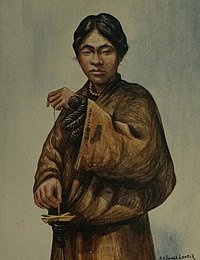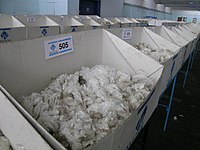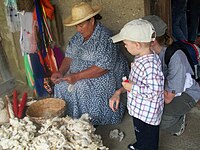Шерсть (материал)
Шерсть — собранный для переработки волосяной покров животных (овец, коз, верблюдов и др.). Основную массу перерабатываемой в промышленности шерсти составляет овечья.
Виды волокон шерсти[править | править код]
- пух (наиболее ценное тонкое, мягкое извитое волокно)
- переходный волос, ость (более толстое, жёсткое и менее извитое, чем пух, волокно)
- «мёртвый волос» (малопрочный и жёсткий).
Способы получения[править | править код]
Шерсть от животных получают, как правило, при помощи стрижки, реже — вычёсыванием.
Ангора - из шерсти кроликов, кашемир и мохер — из шерсти коз, альпака — из шерсти ламы (альпака это разновидность ламы)
Применение[править | править код]
Из шерсти вырабатывают пряжу, ткани, трикотаж, валяльно-войлочные изделия и др.
Шерстяные ткани, вырабатываемые в основном из овечьей шерсти, в продажу поступают под названиями бобрик, бостон, букле, велюр, габардин, диагональ, драп, кашемир, коверкот, плюш, ратин, сукно, трико, фай, шевиот, шотландка и др.
Физико-химические свойства волокон[править | править код]
Термостойкость шерсти невысокая: предельная температура сушки 60—70° С; при температуре 100—105° С шерсть теряет влагу, волокно становится жестким и ломким, а при 120° С шерсть желтеет и начинает разлагаться. Шерсть обладает низкой теплопроводностью, поэтому шерстяные ткани отличаются высокими теплозащитными свойствами.
От извитости шерсти зависят упругость и пористость готовой ткани; овечья шерсть обладает большим упругим удлинением, поэтому она мало мнется и очень эластична; под действием горячей воды растяжимость шерсти сильно повышается — на 25—50 % по сравнению с первоначальной длиной. Гигроскопичность шерсти в нормальных условиях составляет 15—17 %, а в условиях повышенной влажности шерсть поглощает до 40 % влаги, оставаясь сухой на ощупь. Набухшая в воде шерсть после высыхания принимает первоначальную форму, на этом свойстве основаны такие виды обработки шерсти, как декатировка, утюжка, прессовка.
Щёлочь, особенно едкий натр, разрушает волокно шерсти, и изделие становится рыхлым (расползается), поэтому изделия из шерсти рекомендуется стирать нейтральным мылом или специальными синтетическими моющими средствами.
- Для отбеливания шерсти не следует применять соединения, содержащие хлор, так как от хлора шерсть темнеет, становится жесткой, сильно снижается крепость волокон; шерсть рекомендуется отбеливать перекисью натрия, перборатом натрия, гидросульфитом натрия или ронгалитом в слабокислой среде. Для выведения пятен с шерсти можно применять любые растворители, так как они на волокна шерсти не оказывают отрицательного действия.
См. также[править | править код]
- Щетина — более толстые, плотные и твердые волосы млекопитающих, не отличающиеся по своему гистологическому строению от обыкновенных волос.
- Текстильная промышленность
- Кератины - белки, основной компонент шерсти.
Литература[править | править код]
Внешние ссылки[править | править код]
- УКТЗЕД Група 51 Вовна, тонкий та грубий волос тварин; пряжа і тканини з кінського волосу
- Про вовняну пряжу та її різновиди
На англ. языке[править | править код]
- Australian Wool Exchange Ltd
- Australian Wool Innovation (AWI)
- Australian Wool Testing Authority Ltd
- American Wool Industry
- Natural Colored Wool Growers Association
- Australian Wool Fashion Awards
. Australia's colonial economy was based on sheep raising, and the Australian wool trade eventually overtook that of the Germans by 1845, furnishing wool for Bradford, which developed as the heart of industrialized woollens production.

Due to decreasing demand with increased use of synthetic fibers, wool production is much less than what it was in the past. The collapse in the price of wool began in late 1966 with a 40% drop; with occasional interruptions, the price has tended down. The result has been sharply reduced production and movement of resources into production of other commodities, in the case of sheep growers, to production of meat.[1][2][3]
Superwash wool (or washable wool) technology first appeared in the early 1970s to produce wool that has been specially treated so that it is machine washable and may be tumble-dried. This wool is produced using an acid bath that removes the "scales" from the fiber, or by coating the fiber with a polymer that prevents the scales from attaching to each other and causing shrinkage. This process results in a fiber that holds longevity and durability over synthetic materials, while retaining its shape.[4]
In December 2004, a bale of the world's finest wool, averaging 11.8 micron, sold for $3,000 per kilogram at auction in Melbourne, Victoria. This fleece wool tested with an average yield of 74.5%, 68 mm long, and had 40 newtons per kilotex strength. The result was $AUD279,000 for the bale.[5] The finest bale of wool ever auctioned sold for a seasonal record of 269,000 cents per kilo during June 2008. This bale was produced by the Hillcreston Pinehill Partnership and measured 11.6 microns, 72.1% yield and had a 43 Newtons per kilotex strength measurement. The bale realized $247,480 and was exported to India.[6]
During 2007 a new wool suit was developed and sold in Japan that can be washed in the shower, and dries off ready to wear within hours with no ironing required. The suit was developed using Australian Merino wool and it enables woven products made from wool, such as suits, trousers and skirts, to be cleaned using a domestic shower at home.[7]
In December 2006 the General Assembly of the United Nations proclaimed 2009 to be the International Year of Natural Fibres, so to raise the profile of wool and other natural fibers.
Production[править | править код]
Global wool production is approximately 1.3 million tonnes per year, of which 60% goes into apparel. Australia is the leading producer of wool which is mostly from Merino sheep. New Zealand is the second-largest producer of wool, and the largest producer of crossbred wool. China is the third-largest producer of wool. Breeds such as Lincoln, Romney, Tukidale, Drysdale and Elliotdale produce coarser fibers, and wool from these sheep is usually used for making carpets.
In the United States, Texas, New Mexico and Colorado have large commercial sheep flocks and their mainstay is the Rambouillet (or French Merino). There is also a thriving home-flock contingent of small-scale farmers who raise small hobby flocks of specialty sheep for the hand spinning market. These small-scale farmers offer a wide selection of fleece.
Global woolclip (total amount of wool shorn) 2004/2005[8]
- Шаблон:Флагификация/Australia: 25% of global woolclip (475 million kg greasy, 2004/2005)
- Шаблон:Флагификация/China: 18%
- Шаблон:Флагификация/New Zealand: 11%
- Шаблон:Флагификация/Argentina: 3%
- Шаблон:Флагификация/Turkey: 2%
- Шаблон:Флагификация/Iran: 2%
- Шаблон:Флагификация/United Kingdom: 2%
- Шаблон:Флагификация/India: 2%
- Шаблон:Флагификация/Sudan: 2%
- Шаблон:Флагификация/South Africa: 1%
- Шаблон:Флагификация/United States: 0.77%
Organic wool is becoming more and more popular. This wool is very limited in supply and much of it comes from New Zealand and Australia.[9] It is becoming easier to find in clothing and other products, but these products often carry a higher price. Wool is environmentally preferable (as compared to petroleum-based Nylon or Polypropylene) as a material for carpets as well, in particular when combined with a natural binding and the use of formaldehyde-free glues.
Animal rights groups have noted issues with the production of wool, such as Mulesing.
Marketing[править | править код]
Australia[править | править код]

About 85% of wool sold in Australia is sold by open cry auction. Sale by Sample is a method in which a mechanical claw takes a sample from each bale in a line or lot of wool. These grab samples are bulked, objectively measured, and a sample of not less than 4 kg is displayed in a box for the buyer to examine. The Australian Wool Exchange (AWEX) conducts sales primarily in Sydney, Melbourne, Newcastle, and Fremantle. There are about 80 brokers and agents throughout Australia.
About 7% of Australian wool is sold by private treaty on farms or to local wool-handling facilities. This option gives wool growers benefit from reduced transport, warehousing, and selling costs. This method is preferred for small lots or mixed butts in order to make savings on reclassing and testing.
About 5% of Australian wool is sold over the internet on an electronic offer board. This option gives wool growers the ability to set firm price targets, reoffer passed in wool and offer lots to the market quickly and efficiently. This method works well for tested lots as buyers use these results to make a purchase. 97% of wool is sold without sample inspection however as of dec 2009, 59% of wool listed had been passed in from auction. Growers through certain brokers can allocate their wool to a sale and what price their wool will be reserved at.
Sale by tender can achieve considerable cost savings on wool clips large enough to make it worthwhile for potential buyers to submit tenders. Some marketing firms sell wool on a consignment basis, obtaining a fixed percentage as commission.
Forward selling: Some buyers offer a secure price for forward delivery of wool based on estimated measurements or the results of previous clips. Prices are quoted at current market rates and are locked in for the season. Premiums and discounts are added to cover variations in micron, yield, tensile strength, etc., which are confirmed by actual test results when available.[10]
Another method of selling wool includes sales direct to wool mills.
Other countries[править | править код]
The British Wool Marketing Board operates a central marketing system for UK fleece wool with the aim of achieving the best possible net returns for farmers.
Less than half of New Zealand's wool is sold at auction, while around 45% for farmers sell wool directly to private buyers and end-users.[11] Some businesses in New Zealand like Blue House Yarns have turned to selling organic wool, a new trend on wool production.
United States sheep producers market wool with private or cooperative wool warehouses, but wool pools are common in many states. In some cases, wool is pooled in a local market area but sold through a wool warehouse. Wool offered with objective measurement test results is preferred. Imported apparel wool and carpet wool goes directly to central markets, where it is handled by the large merchants and manufacturers.[12]
Uses[править | править код]

In addition to clothing, wool has been used for blankets, horse rugs, saddle cloths, carpeting, felt, wool insulation (also see links) and upholstery. Wool felt covers piano hammers, and it is used to absorb odors and noise in heavy machinery and stereo speakers. Ancient Greeks lined their helmets with felt, and Roman legionnaires used breastplates made of wool felt.
Wool has also been traditionally used to cover cloth diapers. Wool fiber exteriors are hydrophobic (repel water) and the interior of the wool fiber is hygroscopic (attracts water); this makes a wool garment able to cover a wet diaper while inhibiting wicking, so outer garments remain dry. Wool felted and treated with lanolin is water resistant, air permeable, and slightly antibacterial, so it resists the buildup of odor. Some modern cloth diapers use felted wool fabric for covers, and there are several modern commercial knitting patterns for wool diaper covers.
Initial studies of woollen underwear have found it prevented heat and sweat rashes because it more readily absorbs the moisture than other fibers.[13]
Merino wool has been used in baby sleep products such as swaddle baby wrap blankets and infant sleeping bags.
Wool is an animal protein, and as such it can be used as a soil fertiliser, being a slow release source of nitrogen and ready made amino acids.
Researchers at the Royal Melbourne Institute of Technology school of fashion and textiles have discovered that a blend of wool and kevlar, the synthetic fibre widely used in body armour, was lighter and cheaper and worked better in damp conditions than kevlar alone. Kevlar, when used alone loses about 20 per cent of its effectiveness when wet and therefore required an expensive waterproofing process. Wool increased friction in a vest with 28-30 layers of fabric, to provide the same level of bullet resistance as 36 layers of Kevlar alone.[14]
Yarns[править | править код]
Virgin wool is wool spun for the first time.[15]
Shoddy or recycled wool is made by cutting or tearing apart existing wool fabric and respinning the resulting fibers.[15] As this process makes the wool fibers shorter, the remanufactured fabric is inferior to the original. The recycled wool may be mixed with raw wool, wool noil, or another fiber such as cotton to increase the average fiber length. Such yarns are typically used as weft yarns with a cotton warp. This process was invented in the Heavy Woollen District of West Yorkshire and created a micro-economy in this area for many years.
Ragg is a sturdy wool fiber made into yarn and used in many rugged applications like gloves.
Worsted is a strong, long-staple, combed wool yarn with a hard surface.[15]
Woollen is a soft, short-staple, carded wool yarn typically used for knitting.[15] In traditional weaving, woollen weft yarn (for softness and warmth) is frequently combined with a worsted warp yarn for strength on the loom.[16]
Events[править | править код]
A buyer of Merino wool, Ermenegildo Zegna, has offered awards for Australian wool producers. In 1963, the first Ermenegildo Zegna Perpetual Trophy was presented in Tasmania for growers of "Superfine skirted Merino fleece". In 1980, a national award, the Ermenegildo Zegna Trophy for Extrafine Wool Production, was launched. In 2004, this award became known as the Ermenegildo Zegna Unprotected Wool Trophy. In 1998, an Ermenegildo Zegna Protected Wool Trophy was launched for fleece from sheep coated for around nine months of the year.
In 2002, the Ermenegildo Zegna Vellus Aureum Trophy was launched for wool that is 13.9 micron and finer. Wool from Australia, New Zealand, Argentina, and South Africa may enter, and a winner is named from each country.[17] In April 2008, New Zealand won the Ermenegildo Zegna Vellus Aureum Trophy for the first time with a fleece that measured 10.8 microns. This contest awards the winning fleece weight with the same weight in gold as a prize, hence the name.
In 2010 an ultra-fine, 10 micron fleece, from Windradeen, near Pyramul, New South Wales set a new world record in the fineness of wool fleeces when it won the Ermenegildo Zegna Vellus Aureum International Trophy.[18]
Since 2000, Loro Piana has awarded a cup for the world’s finest bale of wool that produces just enough fabric for 50 tailor-made suits. The prize is awarded to an Australian or New Zealand wool grower who produces the year's finest bale.[19]
The New England Merino Field days which display local studs, wool, and sheep are held during January, every two years (in even numbered years) around the Walcha, New South Wales district. The Annual Wool Fashion Awards, which showcase the use of Merino wool by fashion designers, are hosted by the city of Armidale, New South Wales in March each year. This event encourages young and established fashion designers to display their talents. During each May, Armidale hosts the annual New England Wool Expo to display wool fashions, handicrafts, demonstrations, shearing competitions, yard dog trials, and more.
In July, the annual Australian Sheep and Wool Show is held in Bendigo, Victoria. This is the largest sheep and wool show in the world, with goats and alpacas as well as woolcraft competitions and displays, fleece competitions, sheepdog trials, shearing, and wool handling. The largest competition in the world for objectively-measured fleeces is the Australian Fleece Competition, which is held annually at Bendigo. In 2008, there were 475 entries from all states of Australia with first and second prizes going to the Northern Tablelands, New South Wales fleeces.[20]
See also[править | править код]
Production[править | править код]
Processing[править | править код]
Refined products[править | править код]
|
Organizations[править | править код]
Miscellaneous wool[править | править код]Mythology[править | править код]
|
References[править | править код]
- ↑ "The end of pastoral dominance"
- ↑ 1301.0 - Year Book Australia, 2000, Australian Bureau of Statistics
- ↑ "SHEEP, LAMB, MUTTON AND GOAT MEAT
- ↑ Superwash Wool Retrieved on 10 November 2008
- ↑ [1](недоступная ссылка)
- ↑ Country Leader, NSW Wool Sells for a Quarter of a Million, 7 July 2008
- ↑ Shower suit Retrieved on 11 November 2008
- ↑ (September 2005)."WoolFacts" (PDF). Australian Wool Innovation.
- ↑ Speer, Jordan K. (2006-05-01). "Shearing the Edge of Innovation". Apparel Magazine.
- ↑ [2](недоступная ссылка)
- ↑ NZ Wool
- ↑ http://www.sheepusa.org/index.phtml?page=site/text&nav_id=b5cd92c158e527a90be72c1ce8be84a2
- ↑ ABC Rural Radio: Woodhams, Dr. Libby, New research shows woollen underwear helps prevent rashes Retrieved 2010-3-24
- ↑ Blenkin, Max. Wool's tough new image, 2011-04-11. Проверено 9 May 2011.
- ↑ а б в г Kadolph, Sara J., ed.: Textiles, 10th edition, Pearson/Prentice-Hall, 2007, ISBN 0-13-118769-4, p. 63
- ↑ Østergård, Else: Woven into the Earth: Textiles from Norse Greenland , Aarhus University Press, 2004, ISBN 87-7288-935-7, p. 50
- ↑ "2004/51/1 Trophy and plaque, Ermenegildo Zegna Vellus Aureum trophy and plaque, plaster / bronze / silver / gold, trophy designed and made by Not Vital for Ermenegildo Zegna, Switzerland, 2001". Powerhouse Museum, Sydney. Retrieved 2008-04-27.
- ↑ Country Leader, 26 April 2010, Finest wool rewarded, Rural Press, North Richmond
- ↑ Australian Wool Network News, Issue #19, July 2008
- ↑ Walcha News, 24 July 2008, Fletcher Wins Australian Fleece Comp, p.3
External links[править | править код]
Шаблон:Fibers Шаблон:Clothing an:Lana cy:Gwlân eo:Lano gu:ઊન ht:Lenn hu:Gyapjú ln:Nkunza ya mpatá lt:Vilna nn:Ull nv:Aghaaʼ os:Къуымбил qu:Millma yi:וואל -->






